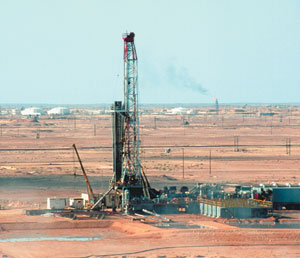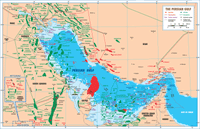|
Aug.
2001 Vol. 222 No. 8
International Outlook
|
MIDDLE EAST
Dr. A. F. Alhajji, Contributing Editor,
Boulder, Colorado
Oman
Economic reform paid off for Oman, which won World
Trade Organization membership last October. The government reduced taxes on foreign-owned businesses from 50%
to 30% at the beginning of 2001 and declared a five-year tax holiday for companies in certain industries.
To diversify its income and reduce its dependence on
oil, Oman adopted an aggressive campaign to explore for and produce natural gas. The campaign was so
successful, that Oman became an LNG exporter in April 2000.
Exploration. Higher oil revenues and a
governmental emphasis on gas have boosted exploration activity. The Enhanced Gas Exploration program
introduced in 1996 has proved to be successful, as more non-associated gas discoveries are made. Oman’s
five-year plan calls for 5 Tcf of additional gas reserves by 2005.
Petroleum Development Oman (PDO) announced new oil and
gas finds last August. One discovery is Sakhaia field in the south, producing 6,200 bopd. Another southern
find, Ghafeer field, will produce 6,000 bopd and 17 MMcfgd. Makarim gas field in the central region should
produce 46 MMcfgd.
PDO also struck two natural gas finds in the central
region this year. The Kauther 1 wildcat was drilled in al-Dakhila, in March. PDO expects this well to be the
largest gas find in the last six years. The second well, Khazzan 1, was found in May. The gas-bearing trap has
up to 90 ft of net reservoir, covering more than 540 sq mi (1,400 sq km). An oil strike in southern Oman was
made at the end of February. PDO said Zazala 1 struck a 64-ft, oil-bearing carbonate structure within a salt
formation at 17,338 ft.
Last March, Maersk Oil signed a four-year contract to
explore Blocks 45 and 48 in western Oman. Use of 2-D seismic declined in 2000, but will increase five-fold in
2001, to 1,398 mi (2,250 km). There were 1,115 sq mi (2,889 sq km) of 3-D acquired, a slight increase.
However, only 463 sq mi (1,200 sq km) are planned for 2001.
Drilling / development. The number of wells
drilled increased last year to 320, including 248 oil completions and 15 gas wells. The Oil Ministry expects
the number of wells in 2001 to increase to 345, including one offshore. However, these conservative numbers
may indicate the lower end of the range.
Gulf Stream Resources will drill four new wells in
Hafar gas field, in Block 30. It also plans to construct a 125-MMcfd, gas processing facility and build a
10-mi tie-in to the main gas transmission line. The company will start gas production in October.
 |
|
Leading Omani operator, PDO, will drill 300
or more development wells to keep oil production close to 900,000 bpd. The company is responsible
for nearly 95% of Oman’s crude production, as well as a similar share of condensate output. (Photo
courtesy of Petroleum Development Oman) |
|
Production. Crude output was nearly level, at
887,880 bpd. However, condensate output more than tripled, to 67,720 bpd. Most of the increase came from new
fields that went onstream in 2000, such as Al-Noor, Mukhaizina and Burhaan. Average oil production during the
first four months of 2001 was 979,000 bpd. Last February, PDO reopened its main pumping station at Qarn Alam
after a $15-million upgrade. The project increased capacity 20%, to 600,000 bopd, and included modifications
to process and export condensate. Natural gas production was 44.4 MMcfd.
 |




